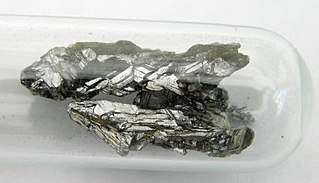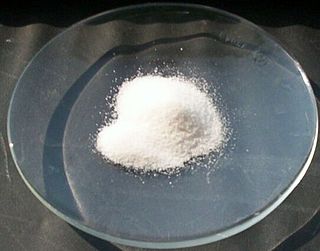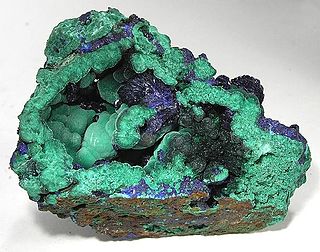
Arsenic is a chemical element; it has symbol As and atomic number 33. It is a metalloid and one of the pnictogens, and therefore shares many properties with its group 15 neighbors phosphorus and antimony. Arsenic is a notoriously toxic heavy metal. It occurs naturally in many minerals, usually in combination with sulfur and metals, but also as a pure elemental crystal. It has various allotropes, but only the grey form, which has a metallic appearance, is important to industry.

Arsenic poisoning is a medical condition that occurs due to elevated levels of arsenic in the body. If arsenic poisoning occurs over a brief period of time, symptoms may include vomiting, abdominal pain, encephalopathy, and watery diarrhea that contains blood. Long-term exposure can result in thickening of the skin, darker skin, abdominal pain, diarrhea, heart disease, numbness, and cancer.

The Marsh test is a highly sensitive method in the detection of arsenic, especially useful in the field of forensic toxicology when arsenic was used as a poison. It was developed by the chemist James Marsh and first published in 1836. The method continued to be used, with improvements, in forensic toxicology until the 1970s.

Arsine (IUPAC name: arsane) is an inorganic compound with the formula AsH3. This flammable, pyrophoric, and highly toxic pnictogen hydride gas is one of the simplest compounds of arsenic. Despite its lethality, it finds some applications in the semiconductor industry and for the synthesis of organoarsenic compounds. The term arsine is commonly used to describe a class of organoarsenic compounds of the formula AsH3−xRx, where R = aryl or alkyl. For example, As(C6H5)3, called triphenylarsine, is referred to as "an arsine".

Arsenic trioxide is an inorganic compound with the formula As
2O
3. As an industrial chemical, its major uses include the manufacture of wood preservatives, pesticides, and glass. It is sold under the brand name Trisenox among others when used as a medication to treat a type of cancer known as acute promyelocytic leukemia. For this use it is given by injection into a vein.
The arsenate is an ion with the chemical formula AsO3−4. Bonding in arsenate consists of a central arsenic atom, with oxidation state +5, double bonded to one oxygen atom and single bonded to a further three oxygen atoms. The four oxygen atoms orient around the arsenic atom in a tetrahedral geometry. Resonance disperses the ion's −3 charge across all four oxygen atoms.

Paris green is an arsenic-based organic pigment. As a green pigment it is also known as Mitis green, Schweinfurt green, Sattler green, emerald, or Vienna green, Emperor green or Mountain green. It is a highly toxic emerald-green crystalline powder that has been used as a rodenticide and insecticide, and also as a pigment. It was manufactured in 1814 to be a pigment to make a vibrant green paint, and was used by many notable painters in the 19th century. The color of Paris green is said to range from a pale blue green when very finely ground, to a deeper green when coarsely ground. Due to the presence of arsenic, the pigment is extremely toxic and in paintings, the color can degrade quickly.

Cacodyl oxide is a chemical compound of the formula [(CH3)2As]2O. This organoarsenic compound is primarily of historical significance since it is sometimes considered to be the first organometallic compound synthesized in relatively pure form.

Copper arsenate (Cu3(AsO4)2·4H2O, or Cu5H2(AsO4)4·2H2O), also called copper orthoarsenate, tricopper arsenate, cupric arsenate, or tricopper orthoarsenate, is a blue or bluish-green powder insoluble in water and alcohol and soluble in aqueous ammonium and dilute acids. Its CAS number is 7778-41-8 or 10103-61-4.
Trimethylarsine (abbreviated TMA or TMAs) is the chemical compound with the formula (CH3)3As, commonly abbreviated AsMe3 or TMAs. This organic derivative of arsine has been used as a source of arsenic in microelectronics industry, a building block to other organoarsenic compounds, and serves as a ligand in coordination chemistry. It has distinct "garlic"-like smell. Trimethylarsine had been discovered as early as 1854.
Potassium arsenite (KAsO2) is an inorganic compound that exists in two forms, potassium meta-arsenite (KAsO2) and potassium ortho-arsenite (K3AsO3). It is composed of arsenite ions (AsO33− or AsO2−) with arsenic always existing in the +3 oxidation state. Like many other arsenic containing compounds, potassium arsenite is highly toxic and carcinogenic to humans. Potassium arsenite forms the basis of Fowler’s solution, which was historically used as a medicinal tonic, but due to its toxic nature its use was discontinued. Potassium arsenite is still, however, used as a rodenticide.
Organoarsenic chemistry is the chemistry of compounds containing a chemical bond between arsenic and carbon. A few organoarsenic compounds, also called "organoarsenicals," are produced industrially with uses as insecticides, herbicides, and fungicides. In general these applications are declining in step with growing concerns about their impact on the environment and human health. The parent compounds are arsane and arsenic acid. Despite their toxicity, organoarsenic biomolecules are well known.

Methyldichloroarsine, sometimes abbreviated "MD" and also known as methyl Dick, is an organoarsenic compound with the formula CH3AsCl2. This colourless volatile liquid is a highly toxic vesicant that has been used in chemical warfare.
Arsenic biochemistry refers to biochemical processes that can use arsenic or its compounds, such as arsenate. Arsenic is a moderately abundant element in Earth's crust, and although many arsenic compounds are often considered highly toxic to most life, a wide variety of organoarsenic compounds are produced biologically and various organic and inorganic arsenic compounds are metabolized by numerous organisms. This pattern is general for other related elements, including selenium, which can exhibit both beneficial and deleterious effects. Arsenic biochemistry has become topical since many toxic arsenic compounds are found in some aquifers, potentially affecting many millions of people via biochemical processes.

Charles Robert Sanger (1860–1912) was a chemist and professor at Harvard University whose research centered on detecting and curing the causes of illness caused by chemicals in the home.

Cacodyl cyanide is a highly toxic organoarsenic compound discovered by Robert Bunsen in the 1840s. It is very volatile and flammable, as it shares the chemical properties of both arsenic and cyanide.

Green pigments are the materials used to create the green colors seen in painting and the other arts. Most come from minerals, particularly those containing compounds of copper. Green pigments reflect the green portions of the spectrum of visible light, and absorb the others. Important green pigments in art history include Malachite and Verdigris, found in tomb paintings in Ancient Egypt, and the Green earth pigments popular in the Middle Ages. More recent greens, such as Cobalt Green, are largely synthetic, made in laboratories and factories.

Compounds of arsenic resemble in some respects those of phosphorus which occupies the same group (column) of the periodic table. The most common oxidation states for arsenic are: −3 in the arsenides, which are alloy-like intermetallic compounds, +3 in the arsenites, and +5 in the arsenates and most organoarsenic compounds. Arsenic also bonds readily to itself as seen in the square As3−
4 ions in the mineral skutterudite. In the +3 oxidation state, arsenic is typically pyramidal owing to the influence of the lone pair of electrons.

Bismuth forms mainly trivalent and a few pentavalent compounds. Many of its chemical properties are similar to those of arsenic and antimony, although much less toxic.















